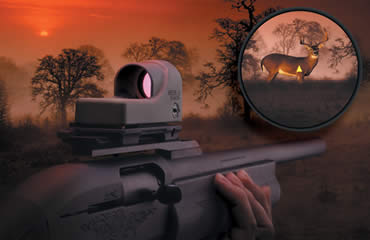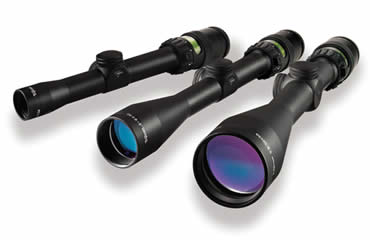By Ralph M. Lermayer
It’s dusk of opening day. You’re easing down a forest road or skirting the edge of a field, when, suddenly, you spot movement in a clearing in front of you. Is it a buck? Whatever it is, it knows you’re there. You instinctively shoulder your rifle. In the blink of an eye, you must locate, identify, evaluate and center the target through a 1 1/2-inch circle of glass before it’s gone.
The sun is barely up. Your electronic call has been wailing out the sounds of a dying rabbit for less than 30 seconds. Something looks out of place at the edge of a clearing 60 yards to your left. Is that the head and shoulders of a fox, coyote, bobcat or fawn? It’s looking at you. You must put the animal in your scope and pull the trigger before it spots you.
You’re moving through unfamiliar territory. All around you are structures that could conceal a potential threat. From any of the endless nooks and crannies, doorways, rooftops or windowsills, a presence could appear that’s intent on killing you and your companions. In an alley 80 yards away, you detect movement in the shadows of a doorway. Is it a harmless shopkeeper, a child or a hostile taking aim? You must shoulder your rifle, locate and identify the target and center it in a small circle of glass in a heartbeat, before it can pull its trigger and someone dies.
There is a very common thread in the above three scenarios. The need for a rapid sight acquisition with a crystal-clear view is important in the first two, but an absolutely life-saving necessity in the latter.
Here, let me go firmly on record. A hunting riflescope should never be used to identify a target. It could be a person or livestock. In the first two scenarios, target identification should be done first and only with binoculars. That uses precious time and creates more movement. Now, getting on that target fast is even more important.
Optics technology has come a long way in the last decade. In the areas of ruggedness, clarity, light-gathering and weather resistance, today’s riflescopes are superb. Reticles, however, have remained pretty basic variations of the standard crosshair. We’ve seen the addition of elevation and windage grids, dual thickness arms, self-illumination (Bushnell Firefly) and a host of battery-powered dots to aid in low-light sighting.
One company, however, driven to help our soldiers in combat, has truly raised the bar and set a new standard for rapid sight acquisition and ultra-fast targeting — and they stepped far from conventional crosshair philosophy to do it.
Trijicon began with the basics. They needed an optic that was not critical to head position. Eye relief had to be very fast and very forgiving. They also relied on a natural tendency of the human eye. Look through a circle, and the object of interest will automatically be centered in that image. Peep sights work on exactly this principle.
What Trijicon did was to highlight that central portion with a pointed chevron or post that not only directs the eye, but also illuminates the aiming point.
This accomplishes two objectives. At dusk or dawn, throughout the day or in the middle of pitch-black darkness, that point is lit and instantly distinguishable. And the brightness of that lighted point directs the eye to it.
Lighted aiming points aren’t new, but Trijicon does it without the use of bulbs or batteries or the fragility of the circuitry associated with battery-powered units. There are no batteries, nor is there a need to shine a flashlight into the unit to activate a limited burst of phosphorescence. Instead, two self-generating power sources provide permanent light.
Tritium3H
Even those well versed in chemistry would have a difficult time explaining this substance. Tritium³H is a weak radioactive isotope of the element hydrogen. Small amounts of it occur naturally, but the most common source for the product used in signs, sights, watches, etc. is from a byproduct of nuclear technology. In essence, it’s a radioactive gas that constantly emits molecules. When those molecules hit phosphor, they cause it to glow.
At Trijicon, they take a small glass tube, coat the inside with phosphor, fill the tube with tritium gas and seal it. After that, it glows for a long, long time, losing only half its power after 12 years. That glowing point is permanently fastened to the internal prism system, where it is moved with the elevation and windage adjustment. In short, a permanently glowing point that is generating its own power. Way cool!

Fiber Optics
The second light source is fiber optics. Imagine a pipe that absorbs light from outside, and then traps it inside, where it must travel to the end of the pipe to escape. On the exterior surface of Trijicon scopes are many of these pipes or threads, totally protected in epoxy. These threads trap even miniscule amounts of light, dusk, dawn, even bright moonlight, and force them to the end of the line, right at the reticle, where the light is concentrated and amplified and shines to illuminate the aiming point.
Two sources of light, both directed to the same spot, result in the glowing aiming point regardless of the light conditions outside.
The Trijicon Chevron
The first time anyone peers through the Trijicon scope and sees the floating inverted V, or chevron, two thoughts come to mind. First, the absence of a crosshair or any vertical or horizontal reference is a bit unsettling. Second is how quickly your eye is pulled directly to the point of that reticle. In an almost unconscious and instinctive reaction, that point is placed where it needs to be on the target. You don’t have to think about it; it’s just there. It’s eerie, but it works.
The Products
All Trijicon products are designed to deliver that instant and automatic sight acquisition and alignment. The product lineup runs from a conventional riflescope, the Accupoint, that now includes both the signature self-lighted central point along with a conventional crosshair, to the smallest red-dot unit I’ve seen. This fits nicely on a revolver or on top of one of their other optics for a double option.
ACOG — Advanced Combat Optical Gunsight
This is the flagship of the Trijicon line, the one that started it all and the one on which hundreds of thousands of U.S. soldiers depend every day. The ACOG is a small fixed-power optic. It is available in 1.5x, 2x, 3x, 3.5x, 4x, 5.5x and 6x, with the newest 6x48 the largest.
A full range of reticles are available, from the basic floating chevron on to several that include the chevron along with ballistic grid lines for long-range shooting. The grid lines are set up for the ballistic drop of .223, .308 or .50-caliber weapons. These are designed to fit on standard Weaver-style bases or on the military specific picatinny multi-slotted rail.
It’s apparent at first glance that the ACOG line is a whole different optic. Its ruggedness is extraordinary. It’s built like a tank! At last year’s SHOT Show, a Trijicon luncheon highlighted a Marine whose ACOG took a bullet. It stopped the bullet, saved his life and miraculously kept on working.
Barely exceeding 7 inches for the largest units and averaging around 5 inches for the smallest, ACOGs also are small, light and compact. But that small size delivers a big-scope eyeful, extremely bright and very forgiving to head position. The ACOG acts like an extension of your eye. No scope finds the target faster.

My personal preference is the 3.5x35 with the amber chevron. It has a permanent home on my rifles used for predator calling, dangerous game or big game hunting in dense, dark cover. Some may doubt the ability of the setup to deliver adequate accuracy at long range. I was a skeptic, but once I became familiar with the inverted chevron reticle, I was able to consistently group about 2 inches at 200 yards. I’ve witnessed younger eyes turn in equal results at longer ranges. In all honesty, I doubt that I could do better with any reticle matched to 3.5 magnification.
For longer range, I would need more power, but for 90 percent of the shots I’ve ever fired afield, this reticle is no handicap. Would the 5.5 or 6x48 do better? Probably, but they come with the tradeoff of much larger size. The objective lens on the 6x is, however, huge, measuring over 2 inches. It is the heaviest of all, designed to match up to a .50 BMG, but delivers a remarkably huge and bright image.
Is it practical for a sporting rifle? Probably not, but the 6x is an amazing example of what optics can be. Perhaps one day the behemoth will be lightened up and made available to the sporting market. Until then, I really like the small, compact stature of the 3.5, 4x and lower-powered units.
The Accupoint
For the purist, this conventional variable riflescope is available in 1.25-4x24, 3-9x40 or 2.5-10x56. Inside, the chevron is on a post, in red or amber, and now the latest, a full crosshair with the dual-lighted center dot. Were it not for the wrap of colored fiber topics on the top of the rear lens, you couldn’t tell it from any other scope. Clamp it to your bases with standard rings.
During periods of very bright sun, the fiber optics on the Accupoint can glow with a phenomenal intensity — to the point of being distracting. To handle this, a cover rotates over however much of the fiber optic area you need to cover to diminish the glow. During full daylight, you can’t see (and don’t need) the tritium input. The Accupoint is a conventional scope with all of the fast-acquisition attributes for which the company is famous.
Even More
The Trijicon product lineup is broad. Peruse the company’s website at www.trijicon.com, and you’ll find optics like the TriPower, an optic that uses tritium, fiber optics and an optional battery-driven light. Trijicon Night Sights are conventional front and rear handgun sights with the tritium tube surrounded in a silicon rubber cushion. Day or night, nothing you can mount on a revolver or pistol delivers a faster sight alignment.
The RedDot, and its bigger cousin, the Reflex, bring the benefits of fast, lighted target acquisition to the handgun or shotgun hunter.
I have to admit that the entrance of Trijicon into the sporting optics arena has left me in quite a dilemma. I’ve never felt the least bit handicapped or lacking with any of my conventional scopes. There have been times when I could clearly see the target, but it was too dark to see the crosshairs. A battery-assisted aiming point could have made the shot possible.
What the Trijicon line clearly illustrates is that while conventional scopes are rugged and bright, we have much room for improvement in how they communicate to our eyes and brain. These products show that optics can move to yet another level beyond the standard crosshair, and I’m sure glad our troops are so equipped.
This article was published in the October 2008 edition of Buckmasters GunHunter Magazine. Subscribe today to have GunHunter delivered to your home.